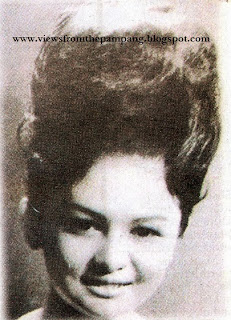Dubbed as Angeles’s fightingest mayor from the day he was elected in 1951, Manuel Abad Santos is best remembered as a town leader who stood firmly on one leg and a crutch, sticking firmly to his principle of standing up for the common good of his people.
That, however, is no wonder for this selfless and fearless town executive, descended from illustrious Kapampangan patriots and leaders. Born on 26 March 1907 to parents Irineo Abad Santos of San Fernando and Teofila Dizon of Angeles, Manuel counts the late martyr-jurist Jose Abad Santos and the great people’s leader, Pedro Abad Santos as uncles.
He grew up in comfortable surroundings—his family were operators of the first moviehouse in Pampanga. His primary education began at the local Angeles Elementary School, then enrolled at Pampanga High School in San Fernando for his first three years of high school. Manuel then transferred to Ateneo de Manila for his senior year. But an unfortunate incident in 1926 would leave him physically maimed for the rest of his life. While in a San Fernando entertainment place, he was caught in a gunfire started by a PC trooper who suddenly went on a shooting rampage. He lost his left leg in that carnage.
Once recovered from his wounds, however, he went back to Ateneo and earned a pre-law degree, an Associate in Arts which he finished in 1927. Manuel, however, opted to work right after college, joining his parents in expanding their burgeoning moviehouse business by adding on two more: Cine Eden and Marte, which became well-known centers of showbiz entertainment in 50s Angeles.
He married Leonarda Atienza of Capas, Tarlac, and their union was blessed with a large brood of 8 children: Manuel Jr., Hollanda, Immaculada, Irineo, Manolita, Antonio, Pedro and Filipinas. In later years, two of their children (Hollanda and Irineo) would be connected with the management and operation of the Angeles Telephone Co.; two boys took up medical studies (Manuel Jr. and Pedro), while another son, Antonio finished Law.
He was already in his mid 40s when, in 1951, he joined the political fray. Running as a minority candidate, he won the mayorship of Angeles by a landslide, signalling the beginning of a long and fruitful career.
In 1955, he replicated his monumental victory at the polls, winning a second mayoral term. This time, however,, his term was marked with bitter and contentious moments with Clark Field and local socio-civic groups.
In 1956, the Clark commander, Col. Karl Barthelmess declared Angeles ”off limits” to military personnel, owing to intimidations allegedly made on servicemen by the local police. Accusations flew back and forth, but even with the ban hurting the local economy, the mayor could not be cowed. “Sovereignty”, he said, “could not be had for a couple of greenbacks”.
In another separate incident, the local Jaycees took offense to a billboard put up by the Mayor which proclaimed his accomplishments. This cause a rift between the mayor and Jaycee members who also happened to be important businessmen—movers and shakers of the town’s economy.
Indeed, this mayor proved once again his pluck and mettle as “the only one-legged mayor of the Philippines and the one with the most kick inspite of his handicap”. He would continue running the affairs of the town with nationalist zeal, and for him, no other accomplishment can be greater than protecting the rights of the people to the best of his ability.
“The greatest good for the greatest number”, was the principle he lived by, maintaining that the welfare of his people is above the law. Manuel Abad Santos was succeeded by his nephew Rafael del Rosario after he finished his term in 1959.



